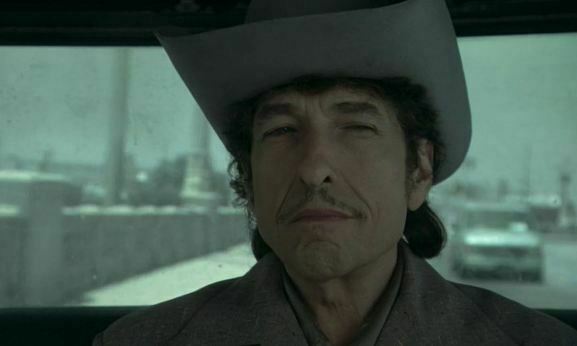
It’s curious how a fine work of art immediately catches the eye. You walk through a gallery, and there is that picture at the far end whose ideal resolution of form and feeling stops all else except its contemplation. You pick up a book at random and on opening at any page a phrase is there telling you instantly that this is a skilled work through and through. Any part of the whole reveals the whole.
So it was in channel-hopping that I saw just thirty seconds of Masked and Anonymous, the 2003 film starring Bob Dylan, being screened to mark the man’s eightieth birthday. I knew immediately that here was a remarkable film. It was there in the framing, in the very balance of things.
I knew of the film but had never seen it. It had been thoroughly trashed by the critics on release, only to gain grudging appreciation in time, but I had never sought it out. Now I did, watching the following night on catch-up. And as those thirty seconds had promised, it was indeed a good film, demonstrating astute judgment from the start that was sustained throughout. Any part of the whole revealed the whole.
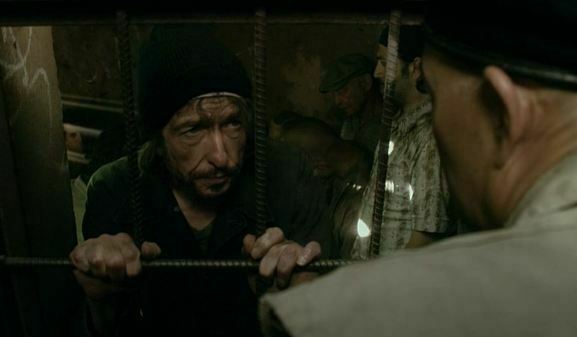
Masked and Anonymous is as good as any American film of the past two decades, and a good deal better than most. It is, I think, the best film with which Dylan has been associated. It is not a film for the mass audience, certainly, hovering as it does between sense and confusion, indifferent to story, hallucinatory in effect. It is set in a future yet present American society that is falling apart. The country has turned into banana republic, governed by an ailing dictator, descending into civil war. A TV benefit concert for the victims of the war is being organised by promoter Uncle Sweetheart (played by John Goodman), who needs money to pay off hoodlums. Frustratingly for him, Paul McCartney, Billy Joel or Sting are not available. The only star he can book is has-been Jack Fate, the son (we eventually learn) of the dictator, who is released from prison for the show. Fate (played by Dylan) rehearses with his band Simple Twist of Fate (played by Dylan’s touring band of the time), as plot and society start to crumble. The dictator dies, the concert takes place. Fate is taken away by troops for a murder he did not commit. Sitting in the back of a van, handcuffed, he thinks aloud:
I was always a singer and maybe no more than that. Sometimes it’s not enough to know the meaning of things, sometimes we have to know what things don’t mean as well. Like, what does it mean to not know what the person you love is capable of? Things fall apart…
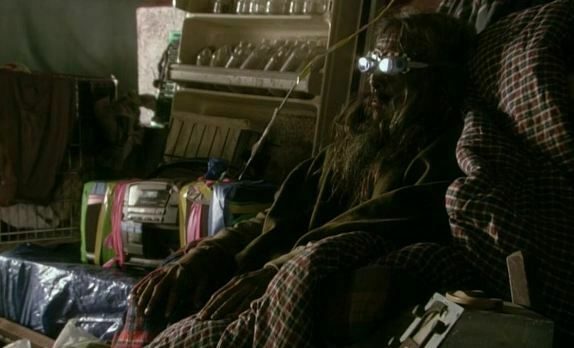
The film is both conceited and wry, a homage to Dylan while mocking the very idea of such worship (Fate is continually told that he is past it, and there’s a great gag when a set list is proposed for him including ‘Street Fighting Man’, ‘Eve of Destruction’ and ‘Kick out the Jams’. “You can do all those”, Uncle Sweetheart assures him). This knowingness inevitably limits its appeal, since anyone who does not recognise the references, or does not care that much for Dylan, will be indifferent if not repulsed by such apparent self-indulgence. But beneath the play with the idea of Dylan/Fate is a serious exposition of the abiding theme of Dylan’s music and outlook, from the 1990s onwards, of the world gone wrong. The album of that title, comprising covers of traditional songs that map out the thesis, was released in 1993. Masked and Anonymous, with its portrayal of corruption and disintegration, where people play at roles that they sense no longer make sense, where money and power have failed, and only song can crystalize some sort of truth, feels like the perfect exposition of Dylan’s prevailing view of things.
The film has two particular qualities. One is the nature of the narrative. Director Larry Charles (now best known as a director of Sacha Baron Cohen films) wanted to the film to have ‘the interior landscape of a great Bob Dylan song – rich with vivid imagery, poetic language and the dance of reality and illusion’. Dylan has consistently come up with songs characterised by a mysterious story and odd characters whose precise connection with one another is never clear, maybe not even to themselves. Songs such as ‘Desolation Row’, ‘Lily Rosemary and the Jack of Hearts’ or ‘Isis’ are films of the mind, working to their own interior logic but which could never actually work on screen in reality – or so it has been argued. Masked and Anonymous is like the Dylan song that finally solved the problem.
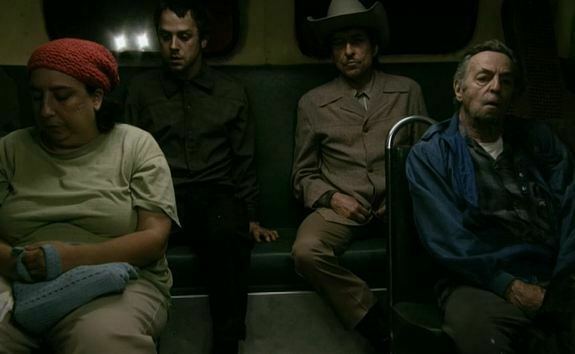
The other quality is Dylan’s presence. As prior dramatic film appearances (Pat Garrett & Billy the Kid, Renaldo & Clara, Hearts of Fire) have demonstrated, Bob Dylan cannot act, but has an extraordinary screen presence nonetheless. He both belongs and yet does not belong on the screen, acting like a comment on the absurdity of human pretension. Why are we acting in this story? But what else can we do? In Masked and Anonymous, however, he comes close to acting quite well. Not well enough so that anyone else would cast him for being anything other than himself, but credible within the bounds of a film which revolves around someone who is a reflection of him.
Of course, Renaldo & Clara (1978) tried the same thing, but that was directed by Dylan, who likes film but has not the first idea how to direct one. Larry Charles does, working from a script by himself and Sergei Petrov (a pseudonym for Dylan, who it seems supplied the rough ideas and characters, jotted down on scraps of hotel stationery, which Charles was able to transmute into something filmic). The film is built around the strangeness of Dylan’s presence. The starry cast – Goodman, Bridges, Jessica Lange, Angela Bassett, Luke Wilson, Penélope Cruz, Val Kilmer, Bruce Dern, Ed Harris, Mickey Rourke…) – put heart and soul into their mysterious roles, yet each finds their scenes stolen by the man who does not act (or who is good at acting someone who does not act). Maybe the only exception is Giovanni Ribisi, whose short scene as a troubled soldier travelling on a bus with Fate, about to meet with fate, is singularly haunting. But Jack Fate leaves him to his death, and travels on.
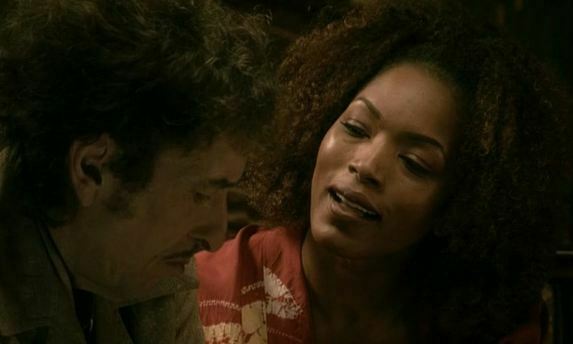
The film has plenty that is wrong with it. The female characters are inconsequential (with the exception of Jessica Lange). Angela Bassett and Penélope Cruz are given little to do that is at all meaningful. Jeff Bridges’s boorish journalist, asking questions about music and motivation to which he does not really want answers, feels like a tired ‘Ballad of a Thin Man’ satire (or Dylan’s fierce assault on an interviewer in Dont Look Back), while his climactic fight with Fate is unnecessary and too absurd (you really can’t imagine Dylan flooring anyone with a punch). The film was shot cheaply and, though richly textured, has a washed-out look that feels almost as though it were shot on video. The famous names (mostly working for union rates) helped secure the funding but look awkward alongside the wordless poor and down-and-outs whose presence feels more true to the kinds of world Dylan conjures up, ones where the sham of borders is exposed.

But it has far more that is good about it. As noted, every composition confirms the excellence of the whole. The film is particularly good at framing Dylan/Fate and his band, with striking use of a wide-angle lens and dynamic positioning of the musicians. The dialogue is compelling even when the sense is unclear – the starry performers must have signed up not just for the chance to be on set with Dylan but because they were given interesting things to say, and interesting situations in which to say them. For a serious, quite obscure film, it’s also lot of fun. Uncle Sweetheart invites supporting acts for the show into his cabin: Dally the Rubber Girl, Eddie Quicksand with Milo, the Great El Mundo with Ellen the Fortune Teller, Abraham Lincoln, Pope John Paul II and Mahatma Gandhi. Only in a Dylan song… Nina Veronica (Jessica Lange) asks if anyone will recognise the songs. “All of his songs are recognisable, even when they’re not recognisable” replies Sweetheart, mocking Dylan’s notorious mangling of his back catalogue in concert.
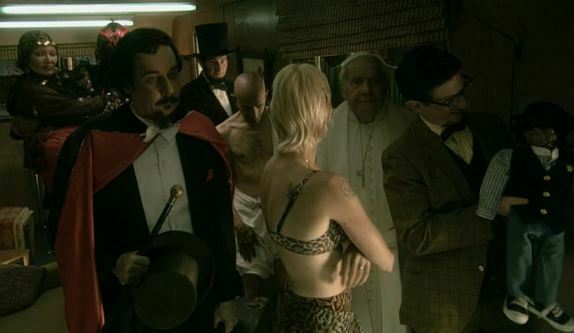
And of course, there’s the music – some terrific live contributions from Dylan and band (‘Down in the Flood’, ‘Cold Irons Bound’, ‘Drifter’s Escape’, ‘I’ll Remember You’, the traditional songs ‘Diamond Joe’ and ‘Dixie’), but significantly some imaginative cover versions on the soundtrack. We hear Italian hip-hop band Articolo 39 mixing up ‘Like a Rolling Stone’, Turkish singer Sertab Erener’s plaintive take on ‘One More Cup of Coffee’, Japanese rockers Magokoro Brothers enthusiastically ripping into ‘My Back Pages’. It is Dylan’s music as world music, the cover as important as the so-called original.
The influence of film on Bob Dylan has often been noted, from the borrowings of lines from favourite films to his wish to make Renaldo & Clara in the mould of one of the French classics (Tirez sur le pianiste, Les Enfants du Paradis). What Masked and Anonymous reveals, to me, is another part of Dylan’s filmic imagination. So many of his songs seem to be attempts to replay films that he has seen, but in the way that he saw them. It’s not that life is a film but that films are turning into something else in his mind. It is expressed most obviously in ‘Brownsville Girl’ – inspired by The Gunfighter (1950), or other Gregory Peck films – and ‘Tempest’, inspired by Titanic (1997) – but the specific is less important than the general. The songs of mysterious narrative or people with strange names who momentarily loom into view, connected though we do not fully sense how, are part of a creative world where life and story are not separated, the imaginary not yet sorted out from the real. It’s a child’s view of things.

I have been reading the works of British educational psychologist C.W. Kimmins. In the 1910s and 20s Kimmins interviewed hundreds of children about their imaginative worlds, including the influence of the new medium of film. Some of the testimonies of cinemagoing that he gathered from children for a 1917 Cinema Commission Inquiry, instituted by the National Council of Public Morals, reveal the great power that films were having on children’s minds. Children were asked to describe films that had made a particular impression on them. They read uncannily like scenarios for Bob Dylan songs, even phrased in the way Dylan might chose to do. Here are three examples:
Joan was a young and beautiful girl of about seventeen years of age, who worked in the mines. Her friend was Lizzie, a pretty girl of about the same age, but fragile and obstinate. Their ‘boss’ as they called the manager, was a young man, handsome and kind. Many a time had he saved Joan from blows from the foreman, and she had grown to love him. Joan’s father was a bully and the terror of the mine.
It was a dull day, and a heavy storm was raging overhead; and a man, evidently a newcomer, entered the inn. He was tall and respectable, with large bright eyes, which seemed to influence everybody. Having had his fill, and the storm having abated, he left the inn and proceeded homewards. On arriving there he sat down and seemed lost in meditation.
A girl had an extremely heroic mother whose husband was locked up in a den of tigers. The woman, who was determined to save her man, boldly went to the circus train where she begged pitifully and melancholily to give her the keys of the den. After a long argument they answered in the affirmative. When she got to the place they said ‘ You can have the keys on one condition only,’ and that was, when she got to the door and unlocked it they must give back the keys. At first she answered in the negative, afterwards she agreed. The second she got into the gloomy cavern she heard her husband’s voice. ‘Is that you, John?’ ‘Who is that?’ came a dreamy and fatigued voice. ‘It is me your wife, Charlotte.’ Then the tears flowed.
It is too fanciful to link Dylan’s songwriting to the impressions of short films from the 1910s on London schoolchildren, but nevertheless it is worth thinking about the way film becomes a part of memory, merging story with experience, driven as we are to feature in the films of our mind’s devising. Dylan has done so through song; in Masked and Anonymous he finally go to do so through film itself.
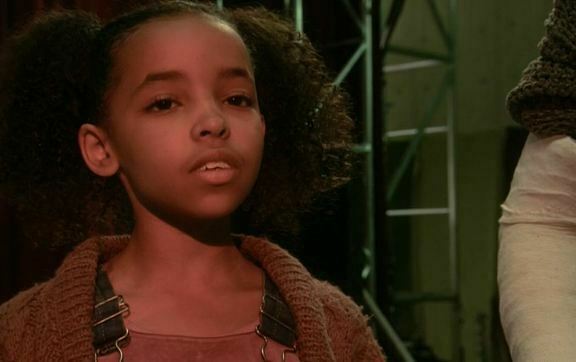
What may be most distinctive about Masked and Anonymous is how it recreates, or at least acknowledges, such an imaginative world from a film’s point of view. It depicts a world where dream and reportage have intermingled. It may be particularly telling that what could be the film’s single most arresting moment is supplied by a child. A young girl (Tinashe Kachingwe) is introduced to Jack Fate and sings an acapella version of ‘The Times They Are A-Changin”. It is breathtaking, like one clear moment of truth in that world gone wrong. One thinks of the young Dylan, turning up with cap, guitar and harmonica at Gerde’s Folk City, sixty years ago now, shaking up his audience: the boy who saw something, in the real world and in his series of dreams.
Links:
- All screengrabs in this post come from BBC iPlayer (the film is on iPlayer for at least a year – it helps that BBC Films co-funded it)
- An example of bad reviews the film originally received is that by Roger Ebert (“vanity production beyond all reason”); an example of critical rethinking is in an essay by poet Andrew Motion (“it allows Dylan to say some important things out loud, and to keep the silences, and retain the elements of mystery, which are essential to his genius”)
- C.W. Kimmins summarises his view of children and cinema in his chapter ‘The Child and the Cinema’ in The Child’s Attitude to Life; a study of children’s stories (1926), available on Hathi Trust. His evidence to the Cinema Commission Inquiry is reproduced in The Cinema: Its Present Position and Future Possibilities (1917), pp. 272-282 (copy on the Internet Archive)